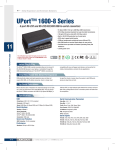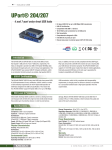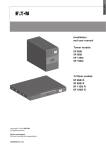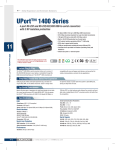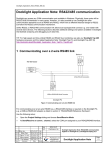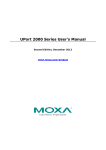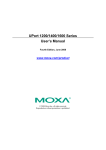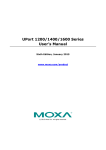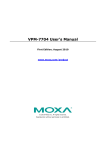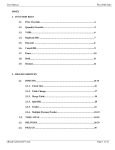Download UPort 1100 Series User`s Manual v2
Transcript
UPort 1100 Series User’s Manual Second Edition, January 2008 www.moxa.com/product © 2008 Moxa Inc., all rights reserved. Reproduction without permission is prohibited. UPort 1100 Series User’s Manual The software described in this manual is furnished under a license agreement and may be used only in accordance with the terms of that agreement. Copyright Notice Copyright © 2008 Moxa Inc. All rights reserved. Reproduction without permission is prohibited. Trademarks MOXA is a registered trademark of The Moxa Inc. All other trademarks or registered marks in this manual belong to their respective manufacturers. Disclaimer Information in this document is subject to change without notice and does not represent a commitment on the part of Moxa. Moxa provides this document “as is,” without warranty of any kind, either expressed or implied, including, but not limited to, its particular purpose. Moxa reserves the right to make improvements and/or changes to this manual, or to the products and/or the programs described in this manual, at any time. Information provided in this manual is intended to be accurate and reliable. However, Moxa Technologies assumes no responsibility for its use, or for any infringements on the rights of third parties that may result from its use. This product might include unintentional technical or typographical errors. Changes are periodically made to the information herein to correct such errors, and these changes are incorporated into new editions of the publication. Technical Support Contact Information www.moxa.com/support Moxa Americas: Toll-free: 1-888-669-2872 Tel: +1-714-528-6777 Fax: +1-714-528-6778 Moxa China (Shanghai office): Toll-free: 800-820-5036 Tel: +86-21-5258-9955 Fax: +86-10-6872-3958 Moxa Europe: Tel: +49-89-3 70 03 99-0 Fax: +49-89-3 70 03 99-99 Moxa Asia-Pacific: Tel: +886-2-8919-1230 Fax: +886-2-8919-1231 Table of Contents Chapter 1 Introduction..............................................................................................1-1 Overview ............................................................................................................................ 1-2 Package Checklist .............................................................................................................. 1-2 Product Features................................................................................................................. 1-2 Product Specifications........................................................................................................ 1-3 LED Indicators ................................................................................................................... 1-4 Adjustable Pull High/low, Terminator Resistors for the RS-485 Port .................... 1-5 Chapter 2 Installation and Configuration................................................................2-1 Initial Driver Installation .................................................................................................... 2-2 Hardware Installation ......................................................................................................... 2-4 Windows 98/ME and Windows 2000 ..................................................................... 2-4 Windows XP, Windows 2003, and Windows Vista (32-bit and 64-bit) ................. 2-5 Configuring the COM Port............................................................................................... 2-10 Configuring the Adaptor....................................................................................................2-11 Removing the Adaptor ..................................................................................................... 2-14 Uninstalling the Driver..................................................................................................... 2-14 Install Linux driver for UPort 1100 Series ....................................................................... 2-16 Chapter 3 Pin Assignment .......................................................................................3-1 UPort DB9 Pin Assignments .............................................................................................. 3-1 Terminal Block Pin Assignments ....................................................................................... 3-1 1 Chapter 1 Introduction The UPort 1100 Series of USB-to-serial adaptors provide an easy way to add COM ports to your computer. The UPort 1110 provides one RS-232 port, the UPort 1130 provides one RS-422/RS-485 port, and the UPort 1150 and UPort 1150I each provide one RS-232/422/485 port. As a plug and play USB device, the adaptors are perfect for mobile, instrumentation, and point-of sale applications. The following topics are covered in this chapter: Overview Package Checklist Product Features Product Specifications LED Indicators ¾ Adjustable Pull High/low, Terminator Resistors for the RS-485 Port UPort 1100 Series User’s Manual Introduction Overview The UPort 1110, UPort 1130, and UPort 1150/1150I are part of Moxa’s UPort line of USB-to-serial adaptors. The UPort line provides a range of easy-to-use solutions for adding COM ports through a PC’s USB port. Simply install the drivers, connect the UPort to your computer, plug in your serial devices, and you’re ready to go. Programming is not required, and you do not need to worry about IRQs, configuring a board, power requirements, or connection schemes. The UPort 1100 series provides single COM port expansion. The UPort 1110 adds one RS-232 port to your computer, which is the same type of COM port that is built into most PC motherboards. The UPort 1130 adds one port that is configurable for RS-422, 2-wire RS-485, and 4-wire RS-485 modes. The UPort 1150/1150I adds one RS-232, RS-422, 2 wire RS-485, or 4 wire RS-485 port to your computer. All of these models can operate at speeds of up to 12 Mbps, which is much faster than the current maximum serial transfer rate. The adaptor is bus-powered, so no external power supply is required. Package Checklist The following items are included in your UPort package: y UPort 1100 Series USB-to-Serial Adaptor y UPort Documentation and Software CD y UPort 1100 Series Quick Installation Guide y 5-year Warranty Statement The UPort 1130/1150/1150I also comes with the following item: y Mini DB9F-to-Terminal-Block Converter NOTE: Notify your sales representative if any of the above items is missing or damaged. Product Features The UPort adaptor has the following features: y Full-Speed USB operation at up to 12 Mbps y Additional I/O or IRQ not required y Serial transmission speed up to 921.6 Kbps y 64-byte FIFO and built-in hardware and software flow control y Built-in 15 KV ESD protection y Support for RS-422, 2-wire RS-485, and 4-wire RS-485 (UPort 1130/1150/1150I) y Terminal block adaptor (UPort 1130/1150/1150I) y 2 KV Optical Isolation Protection (UPort 1150I only) 1-2 UPort 1100 Series User’s Manual Introduction Product Specifications USB Version Connector Speed Serial Interface No. of Ports RS-232 RS-422 RS-485 USB 1.1 (also compatible with USB 1.0 and 2.0) USB type B 12 Mbps 1 TxD, RxD, RTS, CTS, DTR, DSR, DCD, GND TxD+(B), TxD-(A), RxD+(B), RxD-(A),GND 4-wire: TxD+(B), TxD-(A), RxD+(B), RxD-(A), GND 2-wire: Data+(B), Data-(A), GND Connector Male DB9 FIFO 64 bytes Serial line protection 15 KV ESD for all signals Serial Communication Parameters Parity None, Even, Odd, Space, Mark Data bits 5, 6, 7, 8 Stop bits 1, 1.5, 2 Flow control RTS/CTS, XON/XOFF Speed 50 bps to 921.6 Kbps Power Requirements Power Consumption 30 mA@5 VDC Mechanical UPort 1110/1130/1150: 37.5 x 20.5 x 60 mm (L x W x H) Dimensions UPort 1150I: 52 x 80 x 22 mm (L x W x H) UPort 1110/1130/1150: ABS + PC Material UPort 1150I: Metal UPort 1110/1130/1150: 60 g (0.13 lb) Gross Weight UPort 1150I: 80 g (0.17 lb) Environmental Operating Temperature 0°C to 55°C (32°F to 131°F) Storage Temperature -20°C to 85°C (-4°F to 185°F) Operating Humidity 5% RH to 95% RH Regulatory Approvals EN55022 Class B, EN55024, EN61000-3-2, EN61000-3-3, IEC 61000-4-2, IEC 61000-4-3, IEC 61000-4-4, IEC 61000-4-5, IEC 61000-4-8, FCC Part 15 Class B Warranty 5 years 1-3 UPort 1100 Series User’s Manual Introduction LED Indicators UPort 1130 UPort 1110 UPort 1150 Active Active Active TxD TxD TxD RxD RxD RxD 1110 1130 USB-to-Serial Adaptor USB-to-Serial Adaptor 1150 RS-232/422/485 USB-to-Serial Adaptor Name Description Active This LED indicates normal operation. If the driver is installed correctly and the adaptor is plugged into a functioning USB port, the Active LED will light up and remain on. If the LED does not light up, there may be a problem with the adaptor, the driver installation, or PC configuration. TxD This LED blinks when the adaptor transmits data through its COM port. RxD This LED blinks when the adaptor receives data through its COM port. 1-4 UPort 1100 Series User’s Manual 1K Introduction TR ON DIP 1 2 3 150 KX Adjustable Pull High/low, Terminator Resistors for the RS-485 Port In some critical environments, you may need to add termination resistors to prevent the reflection of serial signals. When using termination resistors, it is important to set the pull high/low resistors correctly so that the electrical signal is not corrupted. The UPort uses DIP switches to set the pull high/low resistor values for each serial port. To set the pull high/low resistors to 150 KΩ, make sure both of the assigned DIP switches are in the OFF position. This is the default setting. To set the pull high/low resistors to 1 KΩ, make sure both of the assigned DIP switches are in the ON position. 1 2 3 Pull High Pull Low Terminator ON 1KΩ 1KΩ 120 Ω OFF 150 KΩ 150 KΩ Disable SW 1-5 UPort 1100 Series User’s Manual Introduction ATTENTION Do not use the 1 KΩ setting on the UPort when using the RS-232 interface. Doing so will degrade the RS-232 signals and shorten the maximum allowed communication distance. 1-6 2 Chapter 2 Installation and Configuration Installation of the adaptor is a simple process. First install the driver, then plug the adaptor into a USB port. When the adaptor is plugged in, Windows will load the correct drivers for the adaptor and the new COM port. In this chapter, basic installation and configuration procedures are explained. Although the installation screens will be for Windows 2000, the procedures are essentially the same for Windows 98 and later versions. The following topics are covered in this chapter: Initial Driver Installation Hardware Installation ¾ Windows 98/ME and Windows 2000 ¾ Windows XP, Windows 2003, and Windows Vista (32-bit and 64-bit) Configuring the COM Port Configuring the Adaptor Removing the Adaptor Uninstalling the Driver Install Linux driver for UPort 1100 Series UPort 1100 Series User’s Manual Installation and Configuration Initial Driver Installation The Documentation and Software CD will contain the drivers for the adaptor. You may also download the drivers at www.moxa.com. The installation procedure is the same for all Windows operating systems. Use Windows Explorer to locate the driver installation file, which will be Setup or Install. On the Documentation and Software CD, this file will be located in the UPort 1100/Software folder, filed by operating system. Double-click the Setup or Install file. 1. The Setup Wizard will open. Click Next to begin installing the driver. 2. Click Next to install the driver in the indicated folder, or use the drop-down folder list to locate a different folder. 2-2 UPort 1100 Series User’s Manual Installation and Configuration 3. Click Install to proceed with the installation. 4. A window will pop up cautioning you that this software has not passed Windows logo testing. This is a standard warning, and Moxa has thoroughly tested the driver for safe Windows operation. Please click STOP Installation to proceed. 2-3 UPort 1100 Series User’s Manual 5. Installation and Configuration Click Finish to complete the installation of the driver. Hardware Installation After installing the driver, plug the adaptor into any upstream USB port, such as a USB port on your computer. Windows will automatically detect the adaptor and begin installing the driver. When the Windows finishes installing the driver for the adaptor, it will then detect a new COM port, and will then install another driver for the new COM port. ATTENTION For best results, we recommend that you install the driver before plugging the adaptor into the USB port. Please refer to the previous section on Initial Driver Installation for instructions. Windows 98/ME and Windows 2000 The following instructions are for Windows 98 and Windows 2000 systems: 1. After plugging the adaptor into a USB port, the Found New Hardware window should open automatically. The USB icon indicates that the USB port is being installed. No action is required. 2-4 UPort 1100 Series User’s Manual Installation and Configuration 2. Windows 98 users may skip to the next step. On Windows 2000 systems, a window will pop up cautioning you that this software has not passed Windows logo testing. This is a standard warning, and Moxa has thoroughly tested the driver for safe Windows operation. Please click Yes to proceed. 3. Windows will automatically detect and install the new serial port. No further action is required Windows XP, Windows 2003, and Windows Vista (32-bit and 64-bit) The following instructions are for Windows XP, Windows 2003, and Windows Vista systems. 1. After plugging the adaptor into a USB port, Windows will automatically detect the new device. The Found New Hardware balloon will appear in the bottom right corner of the Windows desktop. No action is required yet. 2-5 UPort 1100 Series User’s Manual Installation and Configuration 2. After a moment, the Found New Hardware Wizard will open. If you see the following screen, select No, not this time, then click Next. 3. On the next window that appears, select Install the software automatically (Recommended), then click Next. 2-6 UPort 1100 Series User’s Manual Installation and Configuration 4. The installation wizard will search for the correct drivers. After a moment, a window will pop up cautioning you that this software has not passed Windows logo testing. This is a standard warning, and Moxa has thoroughly tested the driver for safe Windows operation. Please click Continue Anyway to proceed. 5. Windows will spend a few moments installing the UPort driver. 6. The next window indicates that Windows has completed the installation. Click Finish to continue with installation procedure. 2-7 UPort 1100 Series User’s Manual Installation and Configuration 7. After Windows has completed installing the adaptor, it will automatically detect the new COM port. The Found New Hardware balloon will appear in the bottom right corner of the Windows desktop. 8. The Found New Hardware Wizard will open. If you see the following screen, select No, not this time, then click Next. 9. After a moment, the Found New Hardware Wizard will open. Select Install the software automatically (Recommended), then click Next. 2-8 UPort 1100 Series User’s Manual Installation and Configuration 10. The installation wizard will search for the correct drivers. After a moment, a window will pop up cautioning you that this software has not passed Windows logo testing. This is a standard warning, and Moxa has thoroughly tested the driver for safe Windows operation. Please click Continue Anyway to proceed. 11. Windows will spend a few moments installing the driver. 2-9 UPort 1100 Series User’s Manual Installation and Configuration 12. The next window indicates that Windows has completed the installation. Click Finish to proceed with installation procedure. 13. The Found New Hardware balloon will reappear, indicating that the installation was successful. Configuring the COM Port After the driver and hardware have been successfully installed, the new COM port will have a COM number and can be accessed and controlled just like your PC’s built-in COM ports. If you need to change the baud rate, parity, or other COM port settings, you may use your serial communication application to make those changes. You may also go to Device Manager and right-click the MOXA USB Serial Port, which will be listed under Ports along with your PC’s built-in COM ports. In the context menu that pops up, you may select Properties in order to modify the COM port settings. 2-10 UPort 1100 Series User’s Manual Installation and Configuration Configuring the Adaptor If you need to change the COM number that the adaptor assigns to the COM port, or adjust other advanced settings, you may go to Device Manager and right-click the UPort adaptor, which will be listed under Multi-port serial adaptors. In the context menu that pops up, you may select Properties in order to modify the COM port settings. 2-11 UPort 1100 Series User’s Manual Installation and Configuration In the Port Configuration tab, you will see the new COM port listed. Click Port Setting to modify the COM number and other parameters. 2-12 UPort 1100 Series User’s Manual Installation and Configuration ATTENTION Before modifying these settings, make sure that you have closed any applications that may be accessing the COM port, such as HyperTerminal. You may change the Port Number and enable or disable the Fast Flush function. For the UPort 1130, you may also select between RS-422, 2-wire RS-485, and 4-wire RS-485 modes. Please note that Auto Enumerating COM Number and Set the change to all ports are not available for this model of UPort. * The UPort 1100 only supports RS-232. For this reason, when using the UPort 1100, the Interface drop-down box will be inactive. *The UPort 1150/1150I support RS-232, RS-422, 2-wire RS-485, and 4-wire RS-485. The default setting is RS-232. The Fast Flush function is specifically designed to handle Win32 PurgeComm() function calls and is enabled by default. When Fast Flush is enabled, the driver will automatically clear the local buffer when it receives a PurgeComm() command. When Fast Flush is disabled, the driver will repeatedly query the adaptor until it verifies that there is no more data in the buffer. Disabling this function can cause lower throughput for applications that use PurgeComm() heavily. 2-13 UPort 1100 Series User’s Manual Installation and Configuration Removing the Adaptor The adaptor is a plug and play device. No special procedures are required to remove the adaptor; you may simply pull the adaptor out of the USB port. You should verify that no data is being transmitted before removing the adaptor. Removing the adaptor does not remove the drivers. The drivers remain in place so that the adaptor can be automatically detected and installed if it is pluged back into the USB port. The adaptor can also be uninstalled through the Device Manager, the same as other Windows devices. Right-click the adaptor, which will be found under Multi-port serial adaptors, then select Uninstall from the context menu. Uninstalling the Driver The UPort driver may be removed through Add/Remove Programs in the Windows Control Panel. Click Remove next to MOXA UPort 1110/1130 Windows Driver Ver1.3. 2-14 UPort 1100 Series User’s Manual Installation and Configuration 2-15 UPort 1100 Series User’s Manual Installation and Configuration Install Linux driver for UPort 1100 Series 1. Execute the following commands from the Linux prompt: #mount /dev/cdrom /mnt/cdrom #cd / #mkdir moxa #cd moxa #cp /mnt/cdrom/<driver directory>/ driv_linux2.6_uport1p_vx.x_build_xx.tgz #tar xvfz driv_linux2.6_uport1p_vx.x_build_xx.tgz 2. #cd mxu11x0/driver #make clean; make install 3. #modprobe mxu11x0 2-16 3 Chapter 3 Pin Assignment UPort DB9 Pin Assignments The UPort 1100 series uses male DB9 connectors. Pin assignments are shown in the following diagram: DB9 (male) 1 6 5 9 Pin RS-232 1 2 3 4 5 6 7 8 DCD (in) RxD (in) TxD (out) DTR (out) GND DSR (in) RTS (out) CTS (in) RS-422 4-wire RS-485 TxD-(A) TxD+(B) RxD+(B) RxD-(A) GND 2-wire RS-485 - - Data+(B) Data-(A) GND - Terminal Block Pin Assignments The UPort 1130/1150/1150I comes with a DB9 to terminal block converter, with pin assignments as shown below: Terminal Block Pin RS-422 4-wire RS-485 1 2 3 4 5 TxD+(B) TxD-(A) RxD+(B) RxD-(A) GND 2-wire RS-485 Data+(B) Data-(A) GND Note that the converter maps pin 1 on the DB9 connector to pin 2 on the terminal block, and pin 2 on the DB9 connector to pin 1 on the terminal block.




























